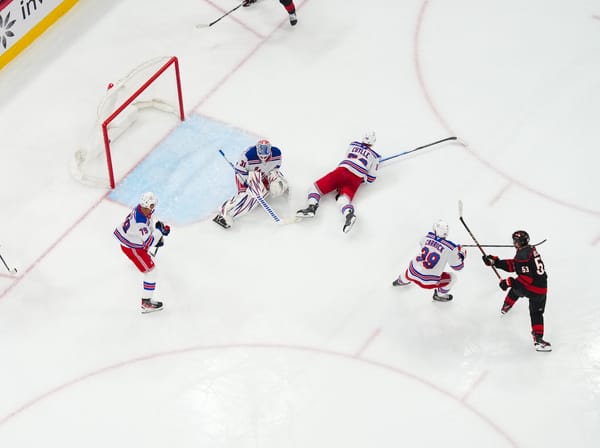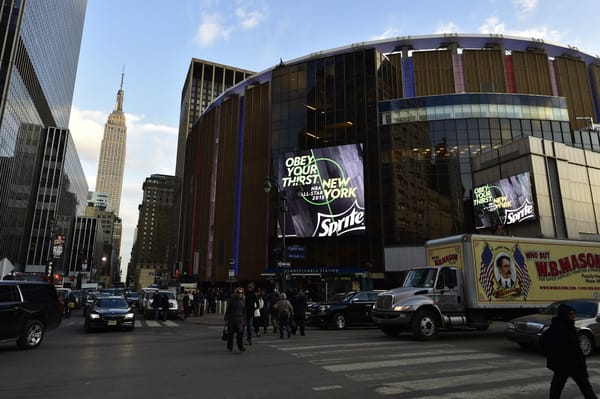Ryan McDonagh and J.T. Miller Trade: Analyzing What the Rangers Got Back
With one of the biggest trading deadline moves in recent memory, the Rangers shipped Ryan McDonagh and JT Miller to Tampa Bay and completely changed the dynamic of the Eastern Conference for the next two seasons. One would expect the Rangers to get back a number of pieces in return, and they did. A trade of this magnitude, and with sentimental attachments, can be overwhelming at first. Now that some time has passed, let’s break down each asset the Rangers acquired and how it relates to a rebuild that has now been made official.
Vladislav Namestnikov
The 25-year-old forward has spent this season winging a line with Steven Stamkos and Nikita Kucherov, though he is naturally a center. In those circumstances, he has produced 20 goals and 24 assists in 60 games. Prior to this season, his career highs was 14 goals and 35 points, and it’s safe to say that his production has been inflated by his playing with two superstars.
But as Alan of Raw Charge pointed out last summer, Namestnikov’s previous point totals don’t do him justice. Namestnikov is the type of player whose overall game tilts the ice in his team’s favor. In a combined look at the 15-16 and 16-17 seasons, Namestnikov ranked third among Tampa Bay forwards in Expected Goals Percentage. Based on shot quality and quantity, the Lightning were expected to have a better ratio of goals with Namestnikov on the ice than they were without him.
And again, as Alan pointed out, one of the ways in which Namestnikov does this is through efficiently pushing the puck up the ice. Tracking data gathered by Corey Sznajder displays this well.
In games tracked over the last two seasons, Vladislav Namistnikov is in the 87th percentile among NHL players when it comes to exiting the defensive zone with possession of the puck. To compare, JT Miller’s 57% is notably lower. Miller does perfectly fine in that aspect of the game, but Namestnikov is borderline elite. Namestnikov also does a very good job of making offensive zone entries.
Namestnikov, at his current pace, extrapolates to 26 goals and 58 points over a full season. Should the Rangers count on getting that kind of production from him going forward? No. He won’t be playing with Stamkos and Kucherov in New York. However, his shooting percentage last season, when he scored just 10, was unsustainably low. Namestnikov will do a decent job of producing on the scoresheet, and he is the kind of center you can deploy in tough assignments. Overall, he’s a player who does a good job of helping your team keep pucks out of your net and put them in the other team’s net. He is a restricted free agent with arbitration eligibility this summer, and it will be interesting seeing to what extent the Rangers establish him as part of the team’s long-term view.
Brett Howden
Drafted 27th overall by the Lightning in 2016, Howden is a 19-year-old center playing in the Western Hockey League. He has registered 22 goals and 36 assists in 38 games for the Moose Jaw Warriors, and was a member of Canada’s World Junior Championship squad which won gold this past January.
At 6’3 and 191 pounds, Howden is a typical Western Canadian power forward. He scores his goals by getting to the net front and using his size and reach to put home and passes or rebounds that come his way. He is a very effective forechecker. He uses smooth, long strides to get up the ice, and uses that size and reach to overpower players and create turnovers.
Howden diverges from the traditional power forward in that he is more of a playmaker than a scorer. He is a precise passer, and has a good feel for how to find players in scoring position. Typically, guys like him sit at the top of the crease on power plays. However, Moose Jaw use him along the half boards because of his ability to see passing lanes develop.
As a few of those highlights show, he has a good sense of how to use his body and reach to shield the puck and create distance between him and players marking him. From there, he has the room to pull of some creative passes into dangerous areas.
What holds Howden back are skating and shooting ability. His skating is fine, but an inability to turn on the jets and reach that next gear limits him to being “good” instead of “great.” The same goes for his shot. The bulk of his scoring comes from around the net front. He simply doesn’t possess the kind of shot that can beat goalies from distance.
Rangers’ General Manager Jeff Gorton has mentioned character multiple times during this process of selling off assets, and it’s an easy inference that Howden’s mental makeup drew the Rangers to him. He has been captain in Moose Jaw for two seasons now and has been lauded for his leadership and presence.
Based on Howden’s production in juniors and makeup, he’s a good bet to make the NHL. However, his upside is questionable. The Athletic’s Craig Custance spoke to “talent evaluators” who project Howden as a third-liner at the NHL level, and one scout I spoke with mirrored that thinking.
“Don’t really see him as a high-end 2C,” the scout said. “Surely more of an above average 3C to me but will be strong on PK and will chip in 5v5 when he gets a mismatch.”
Libor Hajek
Tampa Bay took Hajek with the 37th overall pick in the 2016 NHL draft; a pick they acquired from the Arizona Coyotes in exchange for Tony DeAngelo. According to Sportsnet’s Elliotte Friedman, “Hajek was the guy NYR wanted to seal the deal.”
Hajek, 20, has 11 goals and 24 assists in 52 WHL games. It’s decent production considering that his value lies in his shutdown abilities. He anchored the Czech Republic’s defense at the past World Junior Championships, where the Czechs surprisingly beat Finland and made it to the bronze medal game.
O’Gara notwithstanding, the Rangers made skating ability a clear priority in the defensemen they acquired at the deadline. Hajek is a quick, fluid skater who can either rush the puck out of the defensive zone or quickly close down gaps (look for the #3 jersey in the following clips).
Hajek is able to skate his way out of trouble often, and so he will go through some bumps in his transition to pro hockey, where there’s less room on the ice due to stronger team systems and better skaters. Again, here is what a Western Canada scout had to say:
“Going to struggle moving the puck at the NHL level and will take a good while to get acclimated to the pro pace I think. Think he ends up as a #4 and will be able to handle some big hombres and greasy minutes but won’t move the needle much offensively.”
Like Howden, Hajek is a prospect who comes to the Rangers with multiple years of development already under his belt, but at the cost of upside. In a perfect world, his ceiling is similar to that of a player like Travis Hamonic. More realistically, He has a good shot at becoming a 4-6 defenseman on the roster who eats tough defensive minutes and features on the penalty kill.
2018 First-Round Pick
This one is pretty straightforward. The Rangers received Tampa Bay’s first-round pick for this upcoming June’s draft. The pick’s spot in the draft will be determined by how Tampa Bay’s season finishes. Here is a chart to show all outcomes.
The Lightning are currently the top team in the NHL standings and show no sign of slowing down. There is an outside chance that the Boston Bruins catch the Lightning and win the Atlantic Division, but in all likelihood, this draft pick will fall in the 26-to-31 overall range. Based on research done by TSN’s Scott Cullen and Sportsnet’s Stephen Burtch, players drafted in this range have roughly a 35 to 40 percent chance of making the NHL, with the odds of a team landing a legitimate top-six forward or top-four defenseman being roughly half of that.
As gloomy as that appears, it’s nothing the Rangers don’t understand. The NHL draft is more or less a weighted lottery, and if the Rangers are going to rebuild correctly, then they’re going to need as many scratch-offs as they can get. Each pick (outside of the top-10 or so) is relatively unlikely to land an impact player. Collectively, though, numerous top draft picks give the Rangers a very good shot at landing a special talent or two.
Conditional 2019 First-Round Pick
If Tampa Bay wins the Stanley Cup in either 2018 or 2019, then the Rangers will get their 2019 first-round selection. If not, then the Rangers will get Tampa Bay’s 2019 second-round selection.
Verdict
For pragmatic purposes, this trade can be separated into two components; JT Miller for Vladislav Namestnikov, and Ryan McDonagh for the prospects/picks. By breaking the trade down like that, some context is lost, but it’s an easier way to make sense a complicated transaction.
Why did the Rangers want to swap Miller for Namestnikov? There are a million moving pieces here and a lot of information we don’t know. But there are some discernible reasons for why they might have wanted the switch. For one, the Rangers are moving on from the past and building a brand new team. You don’t want to make trades just for the sake of making trades, but there is merit to the idea of clearing out stagnant water and bringing fresh faces into the locker room. Based on comments from Gorton, the Rangers apparently view Namestnikov as a center going forward. Based on the moves they made, it would appear that they’re prioritizing the center and defensive positions as a focal point for the rebuild. Miller is a free agent with arbitration rights this summer. It’s possible, though purely conjecture on my part, that the Rangers spoke to Miller’s agent and didn’t want to commit to the whatever raise Miller might have been anticipating. It’s also worth noting that Namestnikov is more of a shoot-first player than Miller is, and that’s an area of need for the Rangers both on the current roster as well as throughout the organization’s depth chart.
In regards to McDonagh, it is disappointing that they did not land a prospect with more upside. There are a number of good arguments for making the trade nonetheless. Ottawa will almost certainly be trading Erik Karlsson in the summer, and as such the Rangers would have their market undermined. He also would have held less trade value as a one-year rental, whereas now Tampa Bay paid to get him for two playoff runs.
Staying with the Rangers for the remainder of the season also would probably not have been a great situation for anyone involved. There are still 19 games left, with important evaluations to be done. Inserting a lame duck captain into the locker room and having him address the media every day would have turned awkward at best, and toxic at worst.
As one NHL team’s scout pointed out to me, the package the Rangers received is more or less within range of what late-20s defensemen usually manage to pull. In 2015, Keith Yandle earned Arizona a 1st, a 2nd, John Moore, and Anthony Duclair from the Rangers. In 2013, Jay Bouwmeester was traded from Calgary to St. Louis for a 1st and two low-end prospects. Perhaps McDonagh is better than Bouwmeester was then, and perhaps Duclair was a better prospect at the time than either Howden or Hajek are now. Though it’s not a particularly inspiring return, it’s a pretty respectable haul.
The biggest acquisition in this trade might be the freedom to start anew. Had Rangers’ management merely traded the impending free agents, they could have entered the summer with the temptation of trying to make one last playoff run hovering over their shoulders. Now that they have traded their top defenseman and their second-ranked point producer this season, there is no going back. A dedicated rebuild is the only conceivable path that exists.
Related Article: Analyzing the Michael Grabner Trade




